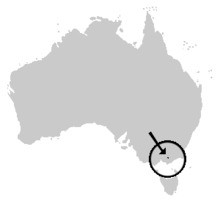Baw Baw frog
| Baw Baw Frog | |
|---|---|
 | |
| Scientific classification | |
| Kingdom: | Animalia |
| Phylum: | Chordata |
| Class: | Amphibia |
| Order: | Anura |
| Family: | Myobatrachidae |
| Genus: | Philoria |
| Species: | P. frosti |
| Binomial name | |
| Philoria frosti Spencer, 1901 | |
 | |
| Range of the Baw Baw Frog | |
The Baw Baw frog (Philoria frosti) is a critically endangered species of Australian frog as categorised on the IUCN Red List and listed under the Flora and Fauna Guarantee Act (1988).
Description
Adult length is between 42 and 55 mm. Adults are dark brown and often have brown to dark brown, yellow flecked bellies. These frogs have a prominent parotoid gland behind each eye. Their toes are unwebbed. At hatching, the tadpoles are creamy white and unpigmented, acquiring some colouration and eye pigmentation as they mature. Tadpoles have large yolk sacs and residual mouths, and do not feed until metamorphosis. Metamorphlings have different colouration to the adults.
Declining population
Population estimates have reduced from 15,000–10,000 breeding males in 1983 to around 750, or according to Frogs Victoria less than 250 individuals. The cause of this reduction is unknown, but the usual suspects of predation by feral animals, habitat degradation, chytrid fungus and ozone layer depletion may each have contributed. The frog's habitat is subject to woodchipping and Hollis cites Malone (1985) as having found significantly higher mortality rates in eggs and tadpoles in disturbed habitats in comparison with those in undisturbed surroundings.
References
- Gillespie; et al. (2004). "Philoria frosti". The IUCN Red List of Threatened Species. IUCN. 2004: e.T16997A6695616. doi:10.2305/IUCN.UK.2004.RLTS.T16997A6695616.en. Retrieved 9 January 2018. Database entry includes a range map and justification for why this species is critically endangered
- Tyler, M. The Action Plan for Australian Frogs Wildlife Australia, Cth. Department of the Envoronment and Heritage, April 1997
- Malone, B.S. (1985a). Status, distribution and ecology of the Baw Baw Frog (Philoria frosti). Arthur Rylah Institute Technical Report No. 36. Arthur Rylah Institute, Department of Conservation, Forests and Lands, Victoria, cited in Hollis, G.J. Baw Baw Frog (Philoria frosti) Recovery Plan 1997-2001 Department of Natural Resources and Environment, October 1997.This small Australian frog has been added to the endangered species list because of its population decline in the past years. In 1983 it was believed that there was between 10000 and 15000 Baw Baw frogs but now as little as 250 are thought to be left. They can be found in eastern Victoria's Baw Baw Plateau (120 km or 75 mi east of Melbourne) and Eucalyptus forests around that area. The adult frogs are very dark and have a lighter pigmented belly. The main characteristic of these frogs is the enlarged parotid glands behind the eyes. Their skin is covered in small warts which give them a prickly appearance. The female tends to be bigger than the male with a length of 51 mm (2 in) compared to 44 mm (1 3⁄4 in), but the males have longer legs and wider heads.
External links
| Wikispecies has information related to Philoria frosti |
- Frogs of Victoria field guide with description, images and sound recording
- Amphibiaweb
- Excellent, detailed description of species and conservation issues by Greg Hollis, Cth Department of the Environment and Heritage, October 1997
- http://www.edgeofexistence.org/amphibians/species_info.php?id=570
- Australian Government, Species Profile and Threats Database (SPRAT) Profile
